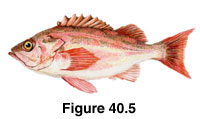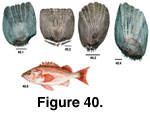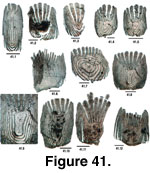 Description
Description
Sebastes proriger
(Redstripe Rockfish)
(Other common names: Redstriped Rockcod)
Figure 40.5
 Description
DescriptionLength: 51 cm.
Mouth: large, terminal, directed forward; lower jaw projects beyond upper jaw; upper jaw extends to mid-orbit; dentary eleveations with teeth at tip of snout; symphseal knob strong and directed upwards.
Body: supraocular, coronal and nuchal spines absent; nasal, preocular, postocular, tympanic, and parietal present but not obvious; five preopercular spines well developed; two opercular spines moderately long; cleithral and supracleithral moderate; spine on lower gill cover margin; caudal fin may or may not be indented.
Color: pale red with mottled olive on dorsal and yellow on lower sides; dusky on top of lower jaw, fins red; dorsal and caudal fins may have yellow; olive stripes radiate from eye; lateral line is light red.
Depth: 25-366 m; shallower in northern waters.
Habitat: rocky reefs and steep cliff faces over open substrate.
Season: ovoviparous; not well determined.
Diet: juveniles each small plankton; adults eat forage fish (e.g., herring, sand lance), and crustaceans.
Predators: not determined.
Distribution: southern California to the Bering Sea.
 Scale Description
Scale DescriptionRelative Scale Size: small to moderate.
Position of Scales on Body: below lateral line canal in 55-60 rows (Hart, 1973).
Overall Shape: they are generally square to rectangular with elongated lateral fields.
Focus and Circuli: the focus abuts the edge of the posterior field, along the edge of ctenii growth and is approximately one-fourth of the total scale length from the outside edge of the posterior margin. The circuli are compact and continuous between the lateral and anterior fields (except broken by radii).
Radii: numbers are variable and not diagnostic. Present only in the anterior field. The outer edge of the anterior field is straight to convex and is moderately scalloped.
 Scale preservation
Scale preservationRockfish scales preserve well in sediments. They are generally in good condition, but are susceptible to erosion, particularly along the leading edge of the anterior fields, and within the edges of the radii. Due to the presence of the cteni, the posterior field usually breaks off, truncating the circuli of the lateral fields. This truncation is one way to tell the difference between rockfish and surfperch scales. In addition, rockfish scales are generally more robust than surfperch, and the circuli are ridged and more pronounced.